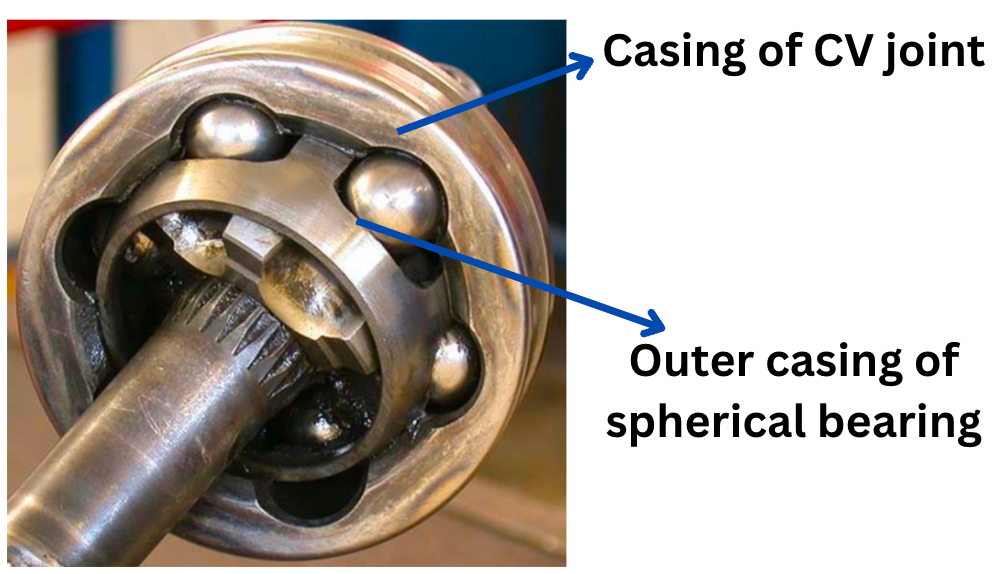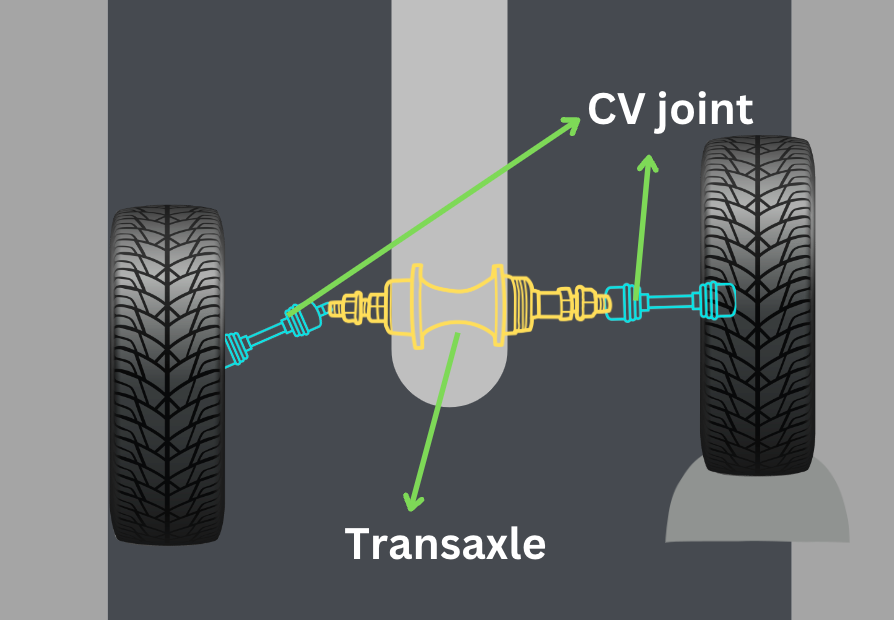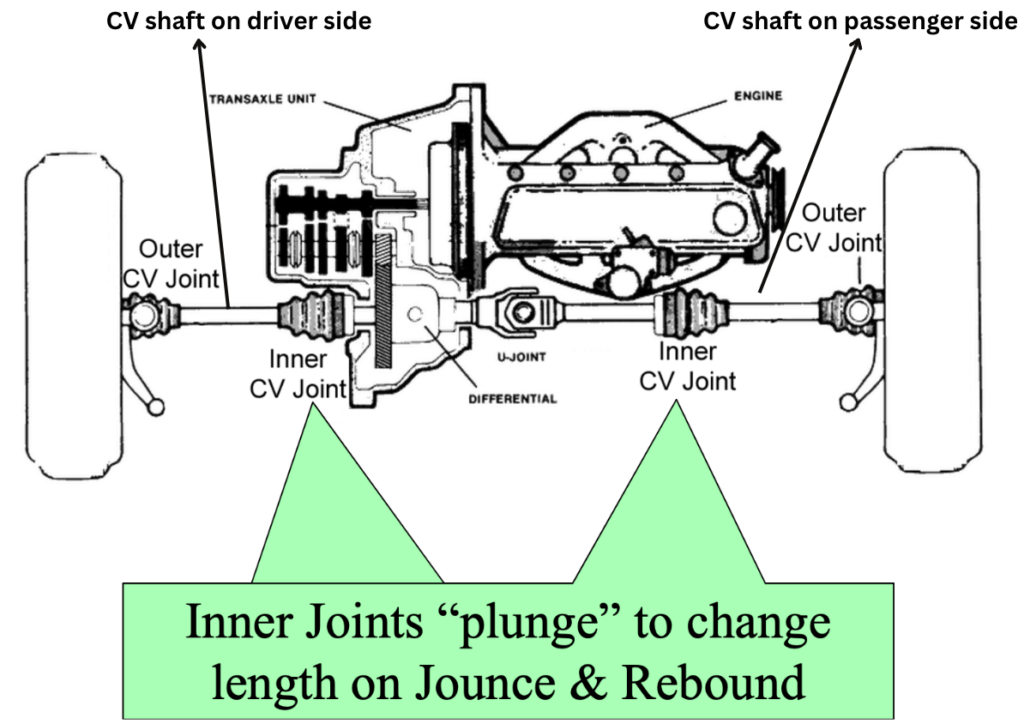Can A Bad CV Joint Affect The Transmission?
A bad constant velocity (CV) joint can indirectly affect your transmission by causing vibrations at high speeds. The CV joint links the transmission to the wheels. A bad CV joint can make noises when turning or speeding up. Clicking and rattling from the CV joint shows a problem. Driving with a broken joint strains the transmission seal where it connects to the transmission. This can start fluid leaks. Losing transmission fluid makes the transmission slip and shift hard. Eventually the transmission can fail. Look at the CV joints regularly. Replace damaged joints right away. This stops harm to the transmission.
A question many owners ask is – can bad CV joints affect your transmission? CV joints let the car run smoothly. Without CV joints, the transmission or driveshaft may fail.
Usually, rough acceleration makes owners think it’s the transmission. But a misfiring engine also vibrates when you press the gas.
You can read my guide on check engine light flashing and car shaking to get further details. Usually, it is due to bad spark plugs, ignition coils, or a bad EGR valve.
- CV joints allow wheels to turn smoothly over bumps by constantly changing angle but keeping speed constant.
- Listen for clicking when turning and clunking when accelerating to diagnose bad outer CV joint.
- Accelerate/decelerate in reverse to diagnose bad inner CV joint – clunking is more pronounced.
- Vibrating axle from bad CV joint causes hard shifting. Can also leak transmission fluid.
What Exactly Is A CV Joint?
A CV joint helps the wheels turn smoothly on cars with four-wheel drive or front-wheel drive. It sends power from the transaxle to the wheels even when the wheels are at different angles.
The inner CV joint links to the transaxle. The outer CV joint goes into the wheel hub.
A CV joint has:
- Ball bearings that are round like balls
- A casing that holds the bearing so it can spin
- A rubber boot

As your vehicle goes over the potholes or bumps, the vehicle’s suspension moves in a respective direction.
The CV joints respond to the suspension movement and keep the drive wheels moving at a constant velocity. A CV joint does this due to constantly changing its angle, thus keeping the rotational speed the same.
CV joints make sure that the tires remain perpendicular to the road and are easy to steer when a vehicle passes over a bump or a pothole in a road.

From a small animation below, you can see how the CV joint constantly changes the shaft angle to keep the speed the same:
All CV joints require a special type of grease packed inside the joint. The rubber boot seals the CV joint. It prevents the grease to leak and also absorbs the load exerting on the bearing of the CV joint.
If the rubber boot of the CV joint cracks, the CV joint will be contaminated with a buildup of dirt and debris, which can damage the surface of one of the balls of the bearing. This can cause the CV joint to slip or lock, which can make steering difficult.
Also Read: Steering wheel turning by itself
What Is CV Axle?
CV axle, also called a CV shaft and half shaft, connects CV joints, transaxle, and wheels to transfer power from the transmission to the wheels. The inner CV joints connect the CV axle to the transaxle.
A vehicle has a CV axle on the passenger and the driver side. The driver side’s CV axle is shorter in length compared to the CV axle on the passenger side.

What Does An Automatic Transmission Consist Of?
An automatic transmission system consists of:
- Torque converter
- Drivetrain (differential)
- Valve body
- Solenoids
- Clutches and bands
Most of the time, problems in transmission, such as missing shifts, and clutch slip occur due to a low level of transmission fluid inside a transmission.
In my guide on transmission shifting hard, you can find the working of automatic transmission and different causes of failure in transmission.
Transmission fluid is responsible for transferring power from the crankshaft to the torque converter, lubricating the gears in the drivetrain, and applying pressure on clutches and bands by passing through solenoids and passages in the valve body to shift gears.
The problem in transmission due to a bad CV joint only occurs if a seal of the transaxle is broken or the driver’s side CV axle isn’t seated properly after CV axle replacement, due to which transmission fluid starts leaking or the level of transmission fluid becomes lower than the optimum level in the transmission system.
Symptoms Of A Bad CV Joint or A Bad CV Axle
The easiest method to tell whether a CV joint of your vehicle is bad is to carefully listen to the clunking sounds and vibrations emanating from your vehicle when taking tight turns (either left or right).
You can notice the following symptoms of a bad CV joint and bad CV axle:
- Clunking noise when reversing or accelerating above 25mph speed
- Clicking noise when taking tight turns
- Vehicle vibrates, bounces, shudders or feels jerky while accelerating
- Rubber boot of the CV joint is cracked
- Excessive grease stains below the tires and on the wheel well
Problems in a Bad CV Joint Interpreted As Problems In A Transmission
Most of the time, some car owners assume that tie rods, sway bar and other suspension components have any link with the transmission system.
As a result, they assume that any vibration, clunking, or popping noise coming out from the front of the vehicle when taking a turn or accelerating a vehicle is attributed to the bad transmission. So, noises from the car front don’t always mean just the transmission is broken.
Actually, when a CV joint becomes bad, torque from the transmission is not being smoothly transferred to the wheels via CV joints, due to which your vehicle may vibrate or makes clunking when accelerating or even shifting from drive to reverse.
So, the chances are that your transmission is fine, and all that jerk and clunking sound from your vehicle is only coming from the bad CV joint.
How to diagnose?
The easiest way to diagnose a bad outer CV joint is to turn your car right in a tight circle on a smooth road, such as a parking lot. If you hear a clicking noise from the left wheel, it means that the outer left CV joint is bad.
Now, if you turn the vehicle left and hear a clicking noise from the right wheel, it means the right outer CV joint is bad. This is because the side to which a car takes a turn always tries to exert strain on the opposite side. So, if the CV joint is bad, it will emit clunking sound.
Inner CV Joint Failure Symptoms
A bad inner CV joint makes clunking noise and causes vibrations in the vehicle while accelerating over 30mph.
If your vehicle shudders or vibrates while accelerating, there is a doubt whether the vibration is due to backlash in gears in the drivetrain or it is due to the bad inner CV joint. The damaged bearing of the transaxle shaft can also cause vibrations in the vehicle when accelerating.
How to diagnose?
One easier way of determining a bad inner CV joint is to quickly accelerate and decelerate the vehicle in reverse. If the clunking noise becomes pronounced, it means one of the inner CV joints is bad.
Another best way to diagnose a bad inner joint is to raise the front of your car and set it on the jack stand. Make sure to put the transmission in park mode.
Put one hand firmly on the inner CV joint hub and move the CV axle back and forth, and up and down as close as to the inner CV joint with the other hand. Make sure the CV joint hub is not moving. If the CV shaft feels excessively sloppy, it means the CV joint needs to be replaced. If the rubber boot of inner CV joint has cracked or ripped off, it is a clear indication of a bad CV joint.
Can A Bad CV Axle Cause Hard Shifting?
A bad CV axle can cause hard shifting problems. This is caused by the transmission being subjected to excessive vibration. The inner CV joint transmits power from the drivetrain of transmission to the wheel.
If there is vibration in the CV axle due to a bad inner CV joint, the gears in the drivetrain will produce clunking sound and will cause hard shifting problems.
Due to a vibrating CV axle, transmission fluid can also leak from the transmission which also causes hard shifting issues in the transmission.
Final Thoughts
So, a bad CV joint or axle can damage transmission if it is causing leakage of transmission fluid from the transmission due to excessive vibration. The bad inner joint causes vibration in the vehicle when acceleration.
However, you should also examine rubber motor mounts, tie rod ends, control arm bushings and transaxle if your vehicle is jerky or vibrating while accelerating.
FAQs
What are the common symptoms of a bad CV joint affecting the transmission?
Symptoms of a bad CV joint affecting the transmission can include vibrations or shuddering during acceleration, clicking or popping noises when turning, and difficulty shifting gears.
Can a bad CV joint cause the transmission to slip?
Yes, a bad CV joint can cause the transmission to slip. The vibrations caused by the worn or damaged CV joint can disrupt the normal operation of the transmission, leading to slipping gears.
Are there any other potential problems that can arise from a bad CV joint affecting the transmission?
In addition to transmission issues, a bad CV joint can also cause damage to other drivetrain components such as the axle shaft, wheel bearings, and differential.
How long can a vehicle be driven with a bad CV joint affecting the transmission?
It is not recommended to drive a vehicle with a bad CV joint affecting the transmission for an extended period of time. Continued driving can cause further damage to the transmission and other drivetrain components.
Can a bad CV joint be repaired or does it need to be replaced?
Depending on the extent of the damage, a bad CV joint can sometimes be repaired by replacing the boot and repacking it with new grease. However, in most cases, a complete replacement of the CV joint is necessary.
How much does it cost to repair or replace a bad CV joint affecting the transmission?
The cost of repairing or replacing a bad CV joint affecting the transmission can vary depending on the make and model of the vehicle, as well as the labor rates. It is best to consult with a mechanic or service center for an accurate estimate.
How can I prevent CV joint and transmission issues?
Regular maintenance and inspection of your vehicle’s CV joints, including checking for any signs of damage or excessive wear, can help prevent potential issues. Additionally, avoiding rough driving conditions and practicing smooth acceleration and deceleration can also help prolong the lifespan of both the CV joint and the transmission.
